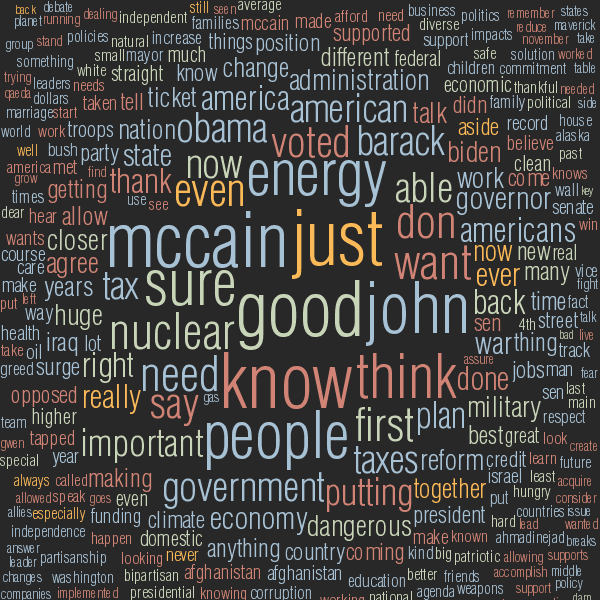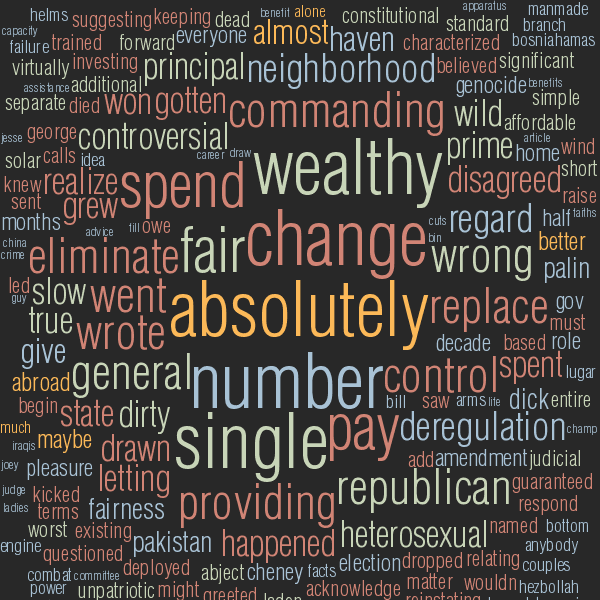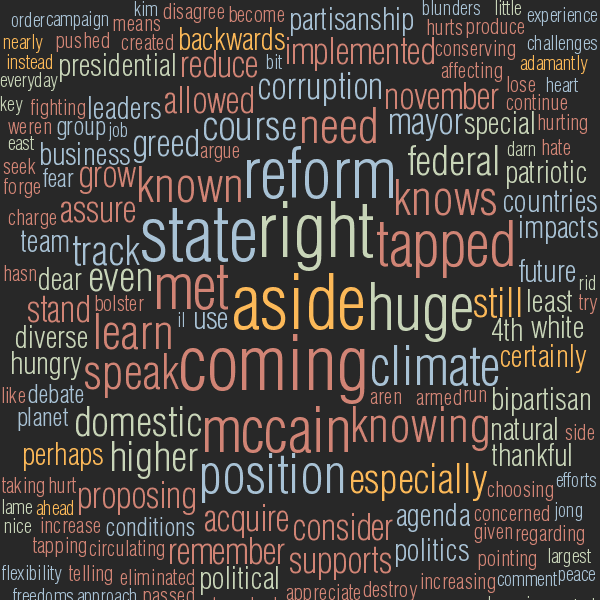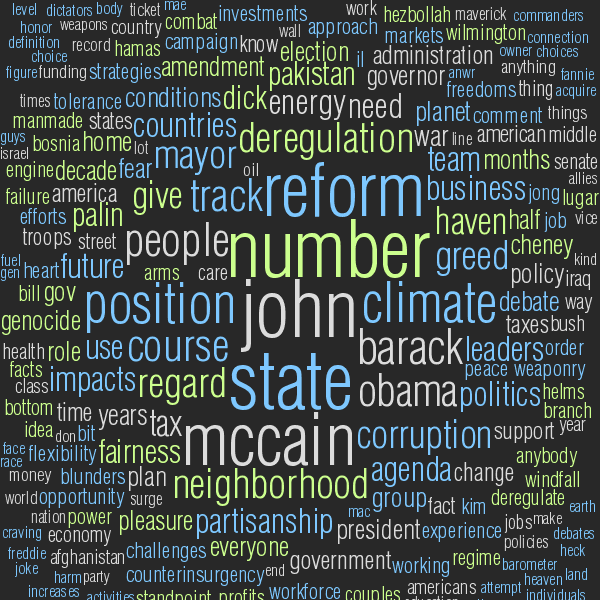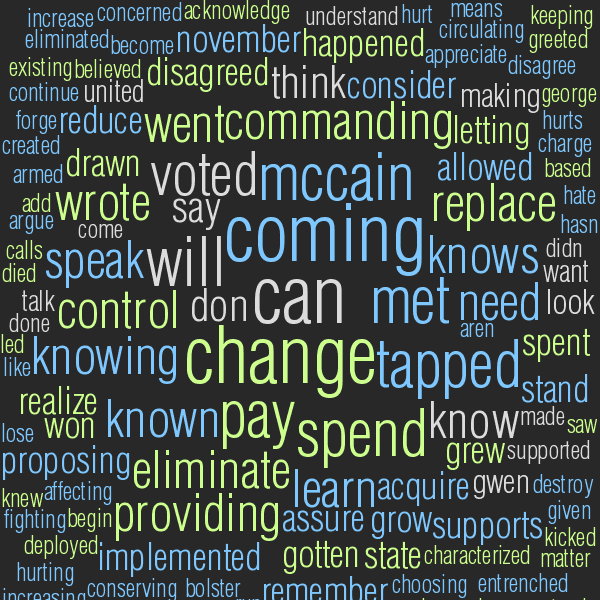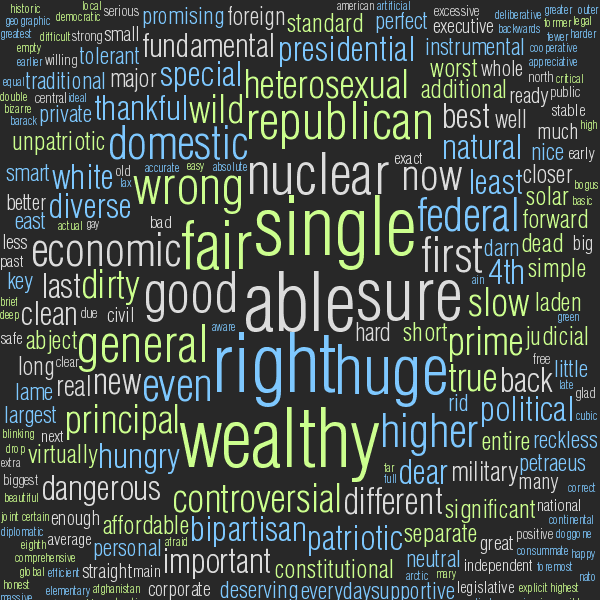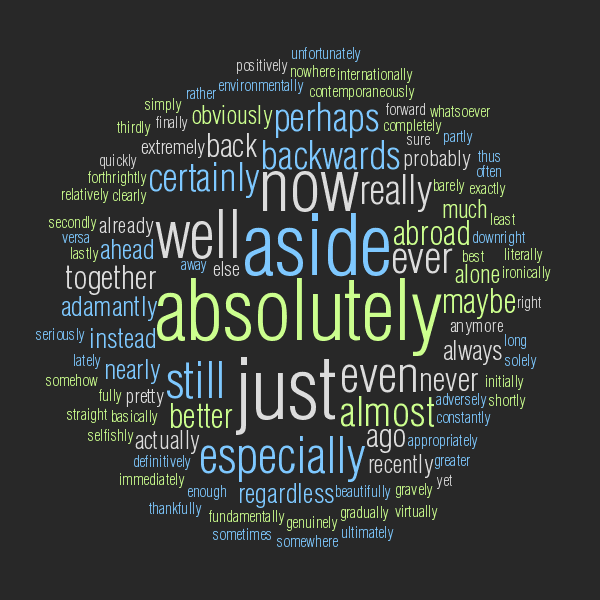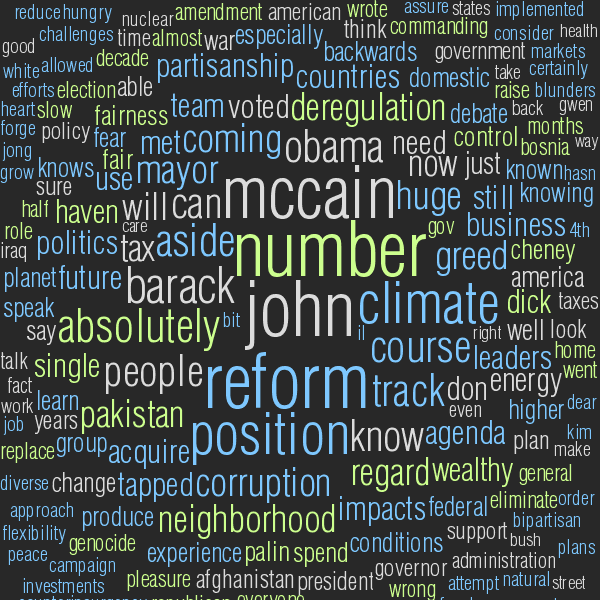Word Analysis of 2008 U.S. Presidential Debates
Joe Biden vs. Sarah Palin
2 October 2008
Word Statistics
Debate Word Count
Summary Word Count
The summary word count reports the total number of words and the
number of unique, non-stop words
used by each candidate. Word number is expressed as both absolute and relative values.
Table 1. Number of all words and unique words used by each speaker.
Table 1 Analysis
Palin is a little bit chattier than Biden, with 7,615 total words compared to his 7,375 (+3.3% more). This difference is about half of the differnce between Obama and McCain (Obama had 7-8% more words than McCain).
On the other hand, both Biden and Palin had a substantially lower unique word ratio at 15.9% and 15.8%, respectively (compare 16.5% for Obama and 17.6% for McCain during the first debate).
Table 1 Legend
Stop Word Contribution
In the table below, the candidates' delivery is partitioned into stop and non-stop words. Stop words are frequently-used bridging words (e.g. pronouns and conjunctions) and do not carry inherent meaning. The fraction of words that are stop words is one measure of the complexity of speech.
Table 2. Expanded analysis of total, stop and non-stop word count.
Table 2 Analysis
Biden has a relatively high non-stop word component in his speech, at 47.1%, higher than Palin (43.9%), Obama (43.4% for first debate) and McCain (44.3% for first debate). Unfortunately, he also suffers from the lowest unique word component, as mentioned above.
Table 2 Legend
All further analysis uses debate content that has been filtered for stop words.
Word frequency
The word frequency table summarizes the frequency with which words were used. Specifically, the average word frequency and the weighted cumulative frequencies at 50 and 90 percentile. The average word frequency indicates how many times, on average, a word is used. For a given fraction of the entire delivery, the weighted cumulative frequency indicates the largest word frequency within this fraction (details about weighted cumulative distribution).
Table 3. Average, 50%, and 90% weighted cumulative word frequencies (content filtered for stop words).
Table 3 Analysis
Biden is highly repetitive, with an average word frequency of 2.96 (+6.5% larger than Palin's 2.78, +12.5% larger than Obama's 2.63, and +17.9% larger than McCain's 2.51).
The speech of Palin is also more repetitive than Obama and McCain, with a 2.78 average word frequency (+5.7% higher than Obama and +10.8% higher than McCain).
Table 3 Legend
Sentence Size
Table 4. Number of words in a sentence, as measured by average number of words, 50% and 90% weighted cumulative values for three word groups (all words, stop words and non-stop words).
Table 4 Analysis
Palin' sentences are enormous, by far the largest of all speakers. She comes in an average sentence length of 8.5 non-stop words (Biden 7.6, Obama 7.7, McCain 7.1). Biden's sentence length is virtually the same as Obama, though Biden uses fewer stop words than Obama (8.6 vs 10.0 per sentence).
Table 4 Legend
Part of Speech Analysis
In this section, word frequency is broken down by their part of speech (POS). The four POS groups examined are nouns, verbs, adjectives and adverbs. Conjunctions and prepositions are not considered. The first category (n+v+adj+adv) is composed of all four POS groups.
Part of Speech Count
Table 5. Count of words (total and unique) categorized by part of speech (POS).
Table 5 Analysis
Biden and Palin are evenly matched in their proportion of parts of speech. Biden tends to repeat his adverbs less than Palin (adverb uniqueness for Biden is 37.6% vs 33.7% for Palin), but repeats his nouns more (noun uniqueness for Biden is 33.8% vs 36.8% for Palin).
Both Biden and Palin show significantly greater noun and adjective repetition than Obama and McCain. For example, uniqueness for nouns was 39.1% and 41.1% for Obama and McCain, respectively, but drops to 33.8% and 36.8% for Biden and Palin. Overall adjective use by Biden and Palin (12.1% and 12.9%) is lower than Obama and McCain (15.1% and 14.2%).
Table 5 Legend
Part of Speech Frequency
Table 5. Frequency of words by part of speech (POS).
Table 5 Analysis
Increased repetition in the speech of Biden and Palin is clearly demonstrated by this table. Average frequency for all parts of speech is increased (except Biden' adverbs), with verbs seeing the smallest increase (2.18/2.13 Biden/Palin vs 2.10/2.06 Obama/McCain) and the largest for nouns (2.96/2.71 Biden/Palin vs 2.56/2.44 Obama/McCain). Biden's adverb repetition is nearly as low as McCain'.
In this debate, as others, verbs are the least repeated words.
Table 5 Legend
Part of Speech Pairing
Through word pairing, I attempt to capture the contextual use of parts of speech within a sentence and extract concepts from the text. Specifically, unique pairs of words indicate complexity and inter-relatedness between concepts in a sentence.
Table 6a (Joe Biden). Word pairs (total and unique) categorized by part of speech (POS) for Joe Biden.
Table 6b (Sarah Palin). Word pairs (total and unique) categorized by part of speech (POS) for Sarah Palin.
Table 6c (Joe Biden vs Sarah Palin). Word Pairs (total and unique) categorized by part of speech (POS) for both candidates.
Table 6 Analysis
Because Palin's sentences were longer than Biden', she is expected to have more word pairings. Indeed, her adverb/* and verb/verb pairings values are 120-150% those of Biden. Interestingly, Palin had fewer noun/noun pairs than Biden (94.3% of Biden).
Both candidates here showed greater repetition of pairs, when compared to Obama and McCain. For example, Biden/Palin unique noun/noun pairs accounted for 74.8%/76.3%, in comparison to 81.5%/79.7% for Obama/McCain.
However, between Biden and Palin, Palin had consistently higher ratio of unique pairs than Biden.
Table 6a,b Legend
Table 6c Legend
Word usage
This section enumerates words that were unique to a canddiate
(e.g. used by one candidate but not the other). For a given part of
speech, the table breaks down the number of words that were spoken by
only one of the candidates or both candidates (intersection). The last
row includes all words (union).
Table 7. Total and unique words used exclusively by a candidate or by both candidates.
Table 7 Analysis
The breakdown of nouns that were exclusive to Biden or Palin, or those that were spoken by both, was nearly the same as for Obama/McCain. Both Biden and Palin each contributed about 36-37% to the unique nouns, with 27% of unique nouns in the debate spoken by both.
The profile of verb, adjective and adverb use is also very similar to the first Obama/McCain debate. When it comes to contribution to unique adjectives. Biden contributed to 34.1% of the unique adjectives, which is similar to McCain at 33.2%, and Palin to 40.9%, which is similar to Obama at 39.8%.
When all parts of speech are considered, the breakdown of contribution to the unique pool is at 36-38% (very similar to 37% seen for both McCain and Obama).
Table 7c Legend
Noun Phrase Usage
Noun phrases were extracted from the text and analyzed for frequency, word count, unique word count and richness.
Top-level noun phrases are those without a parent noun phrase (a parent phrase is one that a similar, longer phrase). Derived noun phrases are those with a parent (more details about noun phrase analysis).
The top-level noun phrases can be interpreted as independent concepts. Derived noun phrases can be interpreted as variants on concepts embodied by the top-level phrases.
Noun Phrase Count
This table reports the absolute number of noun phrases, which is related to the number of total words (specifically, nouns) delivered. The next table presents the number of phrases relative to the number of nouns.
Table 8. Number of noun phrases.
Table 8 Analysis
Biden delivered significantly more noun phrases than Palin, at 923 vs 856 (+7.8% more). However, only 40% of his phrases were top-level, whereas Palin had a fraction of 44.4%. Both values are lower than for Obama and Mccain (who had 46.7% and 45.1%, respectively), though Biden's value was almost 5% lower than Obama, McCain and Palin.
Table 8c Legend
Noun Phrase Richness
The previous table presented the total number of noun phrases, which can be equated to individual concepts. In this table, this value is shown relative to the number of nouns used. The interpretation of this ratio is that of richness. In other words, how many noun phrases were constructed, per noun.
Table 9. Number of noun phrases relative to the number of nouns.
Table 9 Analysis
It looks like Biden and Palin managed to create a greater diversity of noun phrases with their nouns. Biden's value is the highest at 1.21 (ratio of unique noun phrases to unique nouns). Palin's value, 1.13, is higher than McCain (1.07), but lower than Obama (1.16).
When top-level noun phrases are considered (those without a parent noun phrase), Biden has the lowest value (0.55) of Palin (0.57), McCain (0.56) and Obama (0.61). Given that his ratio for all phrases is highest, and top-level phrases is lowest, it can be concluded that he repeats concepts more frequently and recycles his nouns more extensively, to construct similar noun phrases, than the other candidates.
Table 9c Legend
Noun Phrase Frequency and Size
Table 10. Noun phrase frequency, word count and unique word count.
Table 10 Analysis
Both frequency and word count for Biden and Palin were nearly identical. Compared to Obama and McCain, both Biden and Palin had slightly longer noun phrases.
Table 10c Legend
Windbag Index
The Windbag Index is a compound measure that characterizes the complexity of speech. A low index is indicative of succinct speech with low degree of repetition and large number of independent concepts.
Table 11. Windbag Index for each speaker. The higher the value, the greater the degree of repetition in the speech.
Table 11 Analysis
A spectacularly windbaggy showing for Biden, truly earning his nickname. His Windbag Index was 606, 13.4% higher than Palin (535), +43.6% higher than Obama (422) and +64.7% higher than McCain (368).
Biden's index is higher than Palin's due to poor performance in unique non-stop words, nouns, verbs, adjectives and unique noun phrases. In fact, the only place where Biden does better is the non-stop word ratio, adverbs and ratio of unique noun phrases to unique nouns.
Table 11c Legend
Tag Clouds
In the tag clouds below, the size of the word is proportional to
the number of times it was used by a candidate (tag cloud details).
Not all words from a group used to draw the cloud fit in the
image. Specifically, less frequently used words for large word groups
fall outside the image.
Debate Tag Clouds for Each Candidate — All Words
Each candidate's debate portion was extracted and frequencies were
compiled for each part of speech (noun, verb, adjective, adverb), with
words colored by their part of speech category. The words in these
tag clouds include words unique to one candidate as well as words used by
both candidates. For other tag clouds below, only words unique to a
candidate are used.
Keep in mind that the word sizes between tag clouds cannot be
directly compared, since the minimum and maximum size of the words in
each tag cloud is the same. However, the distribution of sizes within
a tag cloud reflects the frequency distribution of words (tag cloud details).
Debate Tag Cloud for Joe Biden — all words
Debate Tag Cloud for Sarah Palin — all words
Debate Tag Cloud Analysis
Recall that Obama' tag cloud featured his debate opponent prominently — Obama used both "John" and "McCain" frequently. However, for Biden the word "Sarah" or "Palin" does not appear within his frequently used words. Instead, he refers to "Obama", "McCain", "John" and, unlike McCain, to "Barack".
Palin also mentions "John" and "McCain", and "Barack" and "Obama", but neither "Joe" nor "Biden" are within the center of her cloud.
Debate Tag Clouds for Each Candidate — Unique Words
The tag clouds below show only used exlusively by a candidate. For
example, if candidate A used the word "invest" (any number of times),
but the other candidate B did not, then the word will appear in the
unique word tag cloud for candidate A.
Debate Tag Cloud for Joe Biden — words unique to Joe Biden
Debate Tag Cloud for Sarah Palin — words unique to Sarah Palin
Unique Word Tag Cloud Analysis
Biden repeats his top nouns significantly — there are hardly any small (i.e. unfrequently used) words in his noun tag. Compare this to Obama's noun cloud, which is richly populated with small words. Take a look at some curious words exclusive to Biden, such as "heterosexual", "dirty" and "genocide".
Palin's tag cloud morphology is similar to McCain's, with a large component of large words. And, like Biden, Palin's repetition of words drowns out less frequently used words from her tag cloud. Curious words for Palin are "lame", "nice", and "blunders".
Part of Speech Tag Clouds
In these tag clouds, words by both candidates were categorized on the
basis of exclusivity to a candidate. Words unique to each candidate
are drawn with a different color. Words used by both candidates are
shown in grey.
The size of the word is relative to the frequency for the candidate
— word sizes between candidates should not be used to indicate
difference in absolute frequency.
Words were further cateogorized by part of speech (noun, verb,
adjective, adverb) and individual tag clouds were prepared for each
category.
The last tag cloud in this section, which uses all (noun + verb +
adjective + adverb) parts of speech.
Tag Cloud of noun words, by speaker
Noun Tag Cloud Analysis
The noun tag cloud is heavily weighted towards unique words by Palin. Unlike the two primary words in the noun tag cloud for Obama/McCain (which were "Obama" and "John"), we do not see the corresponding pairing (e.g. "Palin"/"Sarah" and "Joe"/"Biden") in this cloud. Both "Palin" and "Sarah" are conspicuously absent from the center of the cloud.
Palin's overwhelming contribution to the center of the tag cloud suggests that she touched on, and repeated, concepts not raised by Biden.
Tag Cloud of verb words, by speaker
Verb Tag Cloud Analysis
Contribution by Biden and Palin to the verb tag cloud is more equal. There is a large number of frequently used verbs by either candidate, or both, and therefore the cloud contains relatively few words (when compared to the corresponding cloud for McCain/Obama).
Tag Cloud of adjective words, by speaker
Adjective Tag Cloud Analysis
Biden presses with "fair" and "wealthy", words not used by Palin, whereas Palin uses "right" and "huge". Biden uses "unpatriotic".
Tag Cloud of adverb words, by speaker
Adverb Tag Cloud Analysis
Like Obama, Biden loves "absolutely" and this is his exclusive and most favourite adverb. Biden also uses "contemporaneously", a great word and one that likely was lost on many people.
Tag Cloud of all words, by speaker
All Tag Cloud Analysis
The cloud of all parts of speech clearly illustrate just how much more exclusive and repeated content was found in Palin' delivery.
The cloud also nicely contrasts with the corresponding cloud for the McCain/Obama debate — the vice-presidential debate in general saw a great deal more repetition.
Word Pair Vignette Tag Clouds for Each Candidate
Tag Cloud of word pairs by Joe Biden
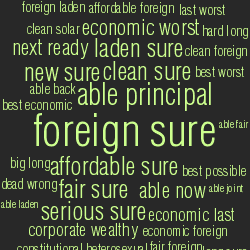
▲
adjective/adjective by Joe Biden

▲
adjective/adverb by Joe Biden
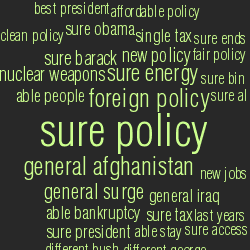
▲
adjective/noun by Joe Biden
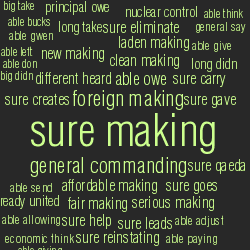
▲
adjective/verb by Joe Biden

▲
adverb/adverb by Joe Biden
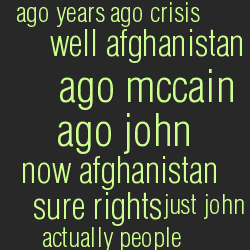
▲
adverb/noun by Joe Biden
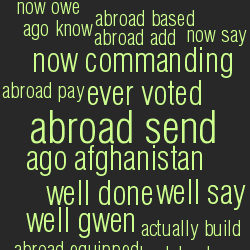
▲
adverb/verb by Joe Biden
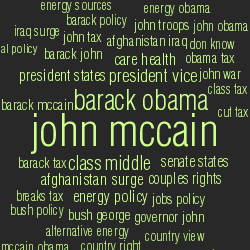
▲
noun/noun by Joe Biden
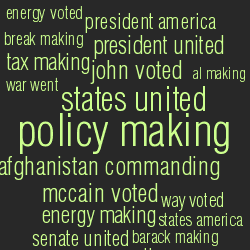
▲
noun/verb by Joe Biden
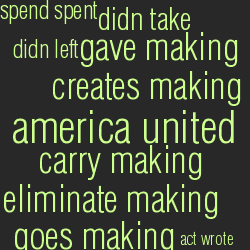
▲
verb/verb by Joe Biden
Word Pair Tag Cloud Analysis for Joe Biden.
Biden' clouds are similar to Obama's in morphology, except for verb/verb which Biden repeats frequently and therefore his cloud has no small text. Biden also has a sparse (i.e. repetitive) cloud for adjective/adverb, suggesting low complexity in combinations of these two modifiers.
Tag Cloud of word pairs by Sarah Palin
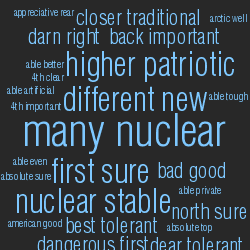
▲
adjective/adjective by Sarah Palin
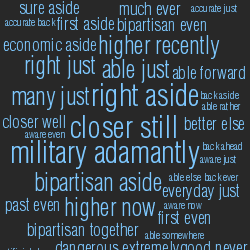
▲
adjective/adverb by Sarah Palin
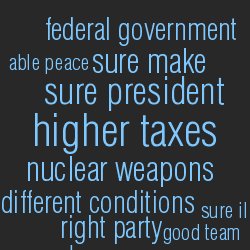
▲
adjective/noun by Sarah Palin
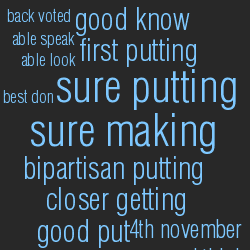
▲
adjective/verb by Sarah Palin
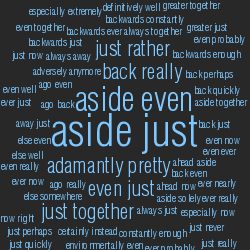
▲
adverb/adverb by Sarah Palin
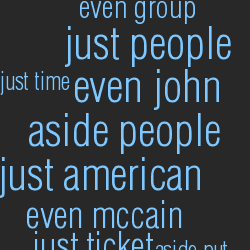
▲
adverb/noun by Sarah Palin
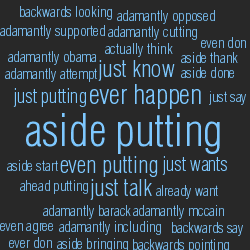
▲
adverb/verb by Sarah Palin
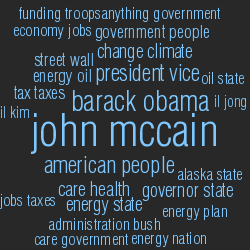
▲
noun/noun by Sarah Palin
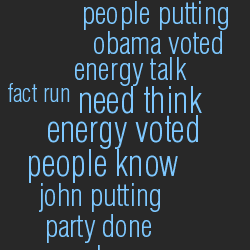
▲
noun/verb by Sarah Palin
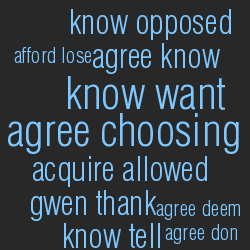
▲
verb/verb by Sarah Palin
Word Pair Tag Cloud Analysis for Sarah Palin.
Palin mongers with "many nuclear" for adjective/adjective and "nuclear weapons" appers prominently in her adjective/noun cloud. Her verb/verb cloud is very sparsely populated, just like Biden's and McCain's. In fact, only Obama had a relatively complex verb/verb tag cloud.
Downloads
debate transcript (courtesy of CNN).
parsed word lists (analyzed transcript, including words by speaker, by POS, and all POS pairings).
tag cloud images
data structure
Please see the methods section for details about these files.


